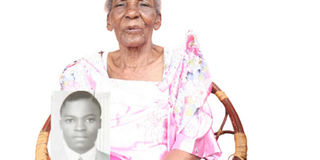My husband died for Kabaka Muteesa

Juliana Yagala-Akuliko says she last saw her husband about a week to the attack on Lubiri. Inset, Tucker Lwanyagga Ddungu, inset, was Kabaka Muteesa’s principal private treasurer at the time of his death in 1966. Photo by Faustin Mugabi
The palace battle was anticipated. And the royal guards were put on alert to fight the enemy.
In spite of the small number, inferior weapons and command compared to the special force commanded by then deputy army commander of the Uganda army, Brig Idi Amin, the royal guards put up a spirited-fight before they were overpowered by a reinforcement from Simba barracks, of Mbarara in southwestern Uganda.
Reinforcements bring victory
The reinforcement was largely composed of Ex-World War II veterans who had just returned from the 1965 Zaire Mission.
It was also the Zaire Mission that partly led to the Lubiri attack especially after Obote’s adversaries claimed he sent the Ugandan troops to Zaire (DR Congo) to plunder gold, Ivory, coffee and timber.
This was against the reality that the OAU had agreed Uganda, Tanzania, Sudan, Zambia were to enter Zaire to support the rebels fighting against Joseph Kasavubu’s government which was backed by the US government after the death of former Congolese prime minister Patrice Lumumba.
It was this force comprised of ex-World War II veterans that massacred the Baganda in the Lubiri.
These, according to the Uganda People’s Congress central were radical Baganda at Mengo who supported the ultimatum that the Uganda government vacates Buganda land by midnight of May 30, 1966 as discussed by the Buganda Lukiiko and endorsed by Kabaka Muteesa I.
Ddungu goes to protect Kabaka
One of those murdered was Tucker Lwanyagga Ddungu, the husband of Juliana Yagala-Akuliko. Ddungu was Kabaka Mutesa’s principal private treasurer also known as “omuwanika wenkuleze” in Buganda.
Ddungu’s widow, Yagala-Akuliko, recently at her home in Munyonyo, Kampala, said that was the last time she saw her husband alive.
In spite knowing that the situation was about to explode, Ddungu went to the palace to be with the Kabaka because that was the moment the king needed the support of his subjects, especially the men.
Yagala-Akuliko said she last saw her husband about a week or so to the Lubiri attack.
Asked about what conversation they had together about the already tense situation, she responded in vernacular: “Owa wanno yali ayagala nyo Kabaka” loosely translated, (my husband loved the king so much”.
She added: “Bweyali addayo mu Lubiri yangamba ntino Obote ayagala kujako obwakabaka naye tugenda kukuma kabaka waffe.”
“When he was returning to Lubiri, he told me that Obote wanted to dissolve Buganda Kingdom. But we are going to protect our King.”
A body never found
On that evening, Ddungu left his home at Munyonyo and went to be with his king. And that was the last time Yagala-Akuliko saw her husband. Fifty years on, no one knows what happened to Ddungu, the man who had capacity to excuse himself and or absent himself like some did to avoid death.
On the morning of May 24, 1966, Elia Lwasa, who was Kabaka Muteesa’s maternal uncle and Yagala-Akuliko’s brother-in-law came and evacuated her and the children to a place around Mengo and hid them.
When the situation had calmed, they returned them to Munyonyo. About the disappearance of her husband Yagala-Akuliko said: “Mukusoka twalowoza ntino yali adduse ne Kabaka okutusa oruvanyuma…” translated: “At first we thought he [Ddungu] had escaped with the king until much later.”
Battle for Mengo hill
In February 1966, prime minister Milton Obote had changed the Constitution, taking the powers of the presidency, formerly held by the Kabaka, to himself.
The Kabaka at the time was Muteesa II. He protested Obote’s actions, ordering him to leave Buganda land and appealing to United Nations Secretary-General U Thant to intervene.
Obote immediately accused the Kabaka of high treason and ordered his aide, Idi Amin, to lead troops against the Kabaka’s residence on Mengo Hill, which was promptly surrounded.
The Kabaka called for his subjects to defend him, and many responded by acts of sabotage throughout Buganda, while thousands of monarchists attempted to set up blockades to hinder Amin’s troops and engaged in running street skirmishes.
However, the Kabaka’s bodyguards were lightly armed with hunting rifles, especially as compared to the army units and, two days after the palace was surrounded, it was overrun and set alight. Kabaka Mutesa II himself escaped the compound during a cloudburst in the middle of the battle.
When Obote sent his soldiers to bring Muteesa to him ‘dead or alive’ the king was unprepared.
Outnumbered, with only 120 guards and facing the Uganda Army it was a losing battle. Determined to protect the King, the [royal] guards knew the only option was for him to flee.
Brief bio
Yagala-Akuliko was born in 1925 to Joshua Zaake, the Kangawo, Bulemeezi county chief. After studying at Gayaza High School, Budo School and Stella Maris Nsube, Mukono, she in March 1942 wedded to Ddungu at Namirembe Cathedral in Kampala.
At the time, Ddungu was secretary to Kabaka Mutesa; but was shortly appointed Bulemeezi county chief until 1964 when he was appointed the “Omuwanika wenkuluze” and was returned to Mengo.




